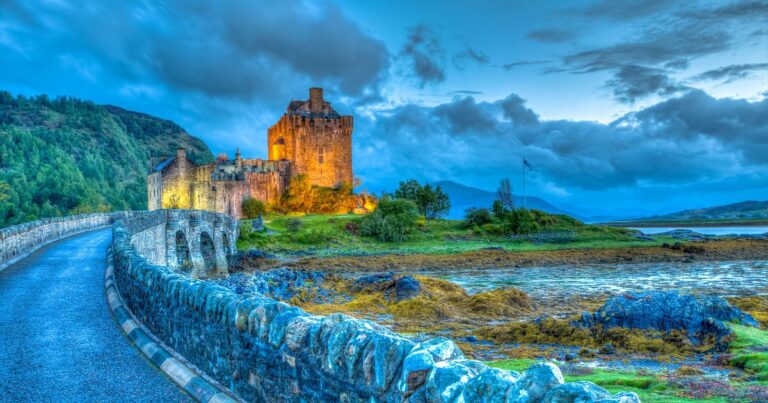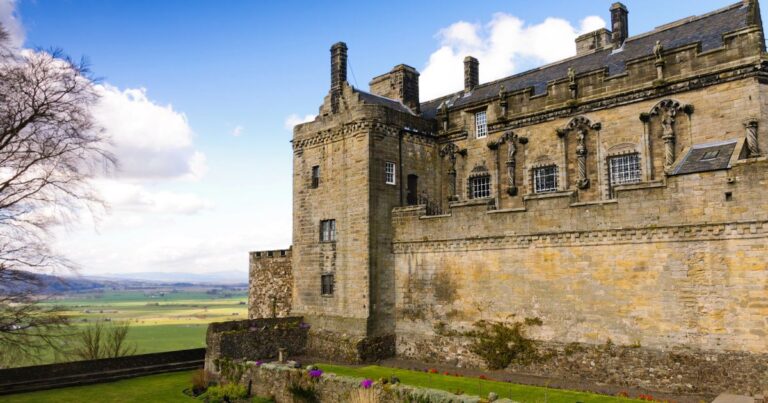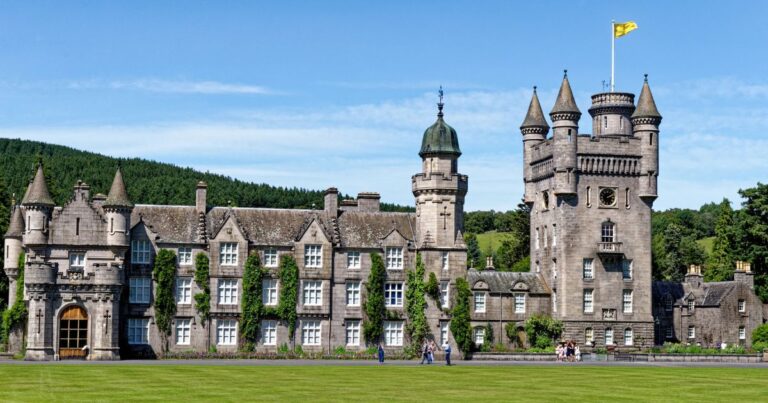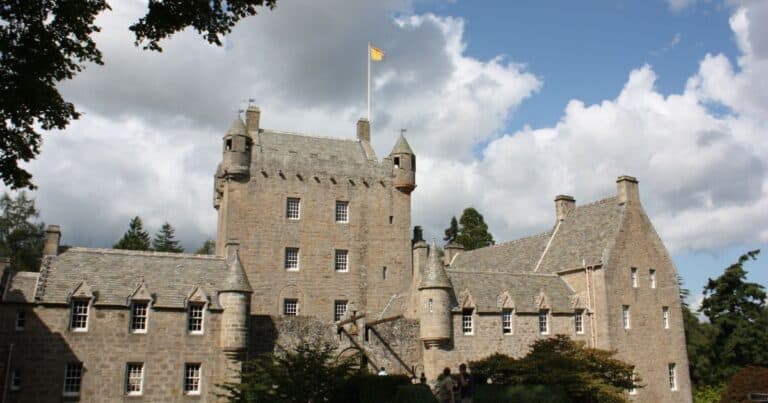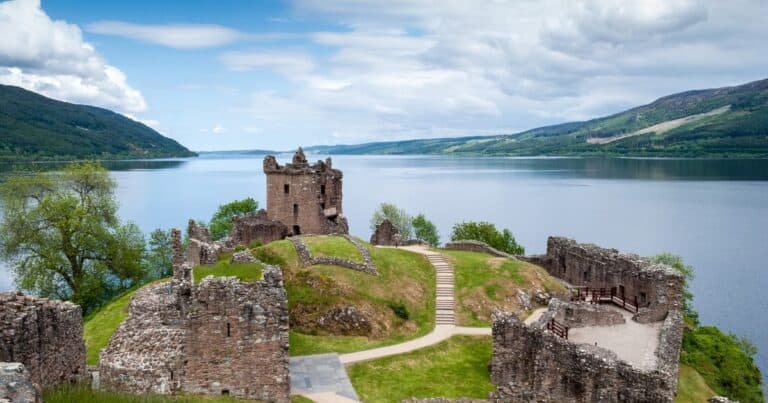Inveraray Castle: A Complete Guide to Scotland’s Grand Ancestral Home

Inveraray Castle sits on the shores of Loch Fyne in the western Highlands, an elegant blend of stately Georgian design, aristocratic lineage, and romantic Scottish landscape. As the ancestral seat of Clan Campbell – one of Scotland’s most influential families – this remarkable estate combines political history, architectural refinement, family heritage, and sweeping Highland scenery into one unforgettable visit.
As a long-time travel advisor who has explored Scotland’s castles many times, I can say Inveraray is one of the most polished, atmospheric, and photogenic estates in the country. Whether you come for its turreted façade, lavish state rooms, or the breathtaking grounds surrounding it, Inveraray delivers a rich and immersive Highland experience.
This complete guide covers the castle’s history, interiors, architecture, gardens, notable figures, legends, and practical tips to plan the perfect visit.
Historical Snapshot
- Location: Inveraray, Argyll & Bute, Scottish Highlands
- Founded: Original castle 1400s; current structure built 1740s–1780s
- Built For: The Dukes of Argyll, chiefs of Clan Campbell
- Style: Gothic Revival + Palladian influences
- Famous For: Grandeur, aristocratic heritage, romantic façade, weapons collection
- Best For: Architecture lovers, Highland scenery, clan history, elegant interiors
Planning a broader trip through the region? You can Explore Scottish Castles here.
Table of Contents
Historical Overview
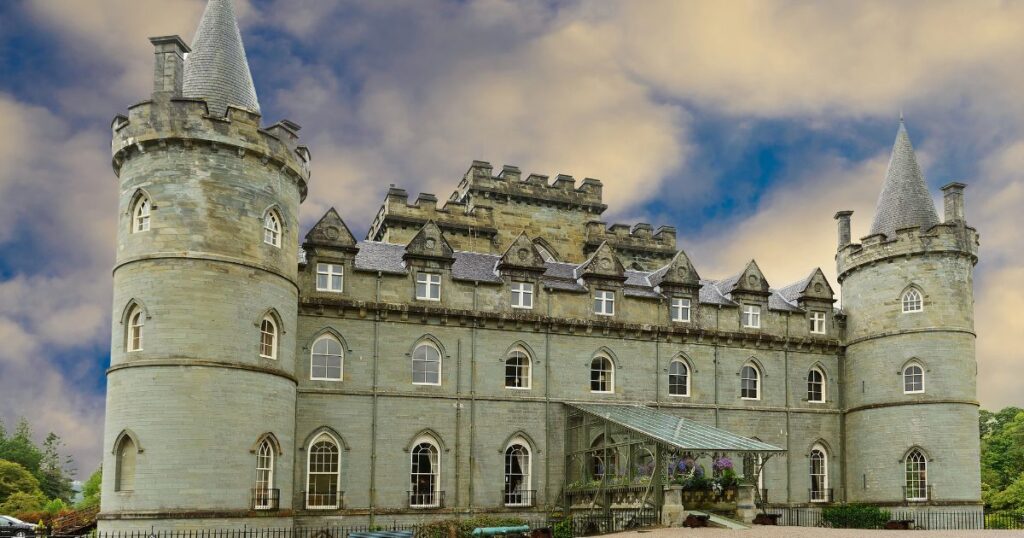
Inveraray Castle is closely tied to the story of Clan Campbell, one of Scotland’s most powerful families for more than 700 years. The original 15th-century stronghold overlooked Loch Fyne, but by the mid-1700s the 3rd Duke of Argyll envisioned something far more ambitious: a modern palace inspired by European design but rooted in Scottish character. The result was one of Britain’s earliest Gothic Revival estates, blending symmetry and refinement with fairytale turrets and battlements.
If you’re interested in exploring more historic fortresses across the country, visit our full Castles in Scotland Guide.
The castle became a symbol of Campbell power, hosting statesmen, royalty, military leaders, and cultural icons. Over the centuries, the Dukes expanded the estate, curated an impressive furniture and arms collection, and landscaped one of the largest designed parklands in Scotland.
Today, Inveraray remains the private residence of the current Duke of Argyll, with many rooms open to the public – a rare opportunity to explore a lived-in aristocratic estate.
Architectural and Design Highlights
Inveraray Castle is one of the earliest and finest examples of Gothic Revival architecture in Britain, uniquely blended with Palladian symmetry and Georgian refinement. Its design was groundbreaking in the mid-1700s — romantic yet formal, elegant yet fortified — and the castle remains one of the most visually striking aristocratic residences in Scotland.
The Castle Exterior
The exterior is a masterclass in harmonious design, combining clean geometry with whimsical Gothic elements. The castle’s four circular corner towers – each capped with tall conical roofs – create its signature fairytale appearance, while the central block remains firmly Georgian in layout. The façade includes:
- Uniform ashlar stonework that shifts from gray to green depending on the Highland light
- Gothic-arched windows framed by delicate stone detailing
- Crenellated parapets adding a subtle military silhouette
- Symmetrical wings that keep the Palladian influence intact
- Graceful vertical lines that draw the eye toward the turrets and rooftop
The castle sits in a wide, open landscape, allowing visitors to admire its full profile — a rarity among Scottish estates where many castles crowd tight hilltops or enclosed settings.
The State Dining Room
This formal entertaining space showcases the castle’s French influences, introduced during the 18th century when European tastes shaped aristocratic Scottish interiors. The room features:
- Flamboyant rococo plasterwork in white and gold, designed by French craftsmen
- Tall arched windows that bathe the room in natural light
- A long polished dining table used for ceremonial dinners
- Silk-lined seating and gilded mirrors that heighten the sense of elegance
- Period-appropriate sideboards and porcelain displays chosen by successive Dukes
The dining room was meant to impress, and it still does — it feels as though it could host a royal banquet at any moment.
The Tapestry Drawing Room
One of the most admired rooms in the castle, the Tapestry Drawing Room embodies the delicacy and refinement of Georgian taste. Its highlights include:
- Rare Beauvais tapestries commissioned in the 1700s
- Pastel-toned walls and carved moldings that brighten the room
- Marble fireplaces with rococo ornamentation
- Gracefully arranged seating areas used historically for tea, music, and conversation
- Portraits and decorative objects belonging to the Campbell family
This room has a soft, romantic aesthetic that balances perfectly with the castle’s more robust Gothic architectural elements.
The Armoury Hall
Standing three stories tall, the Armoury Hall creates an atmosphere of power and military heritage. Its dramatic displays include:
- An enormous radial “sunburst” of muskets and rifles arranged along the walls
- Lochaber axes, swords, and polearms that illustrate Scottish martial history
- Historic pistols and regimental weapons collected over centuries
- Heraldic shields and banners representing branches of Clan Campbell
- Vaulted ceilings that amplify the room’s scale and echo with footsteps
It’s one of the most visually commanding rooms in any Scottish castle, and a clear statement of the family’s historic role in national politics and warfare.
Private Family Rooms
Although Inveraray remains the private residence of the Duke of Argyll, select family spaces are viewable during public visits. These rooms reveal:
- A blend of antique furnishings and modern comforts
- Personal photographs, books, and heirlooms
- Warm, everyday touches that remind visitors this is still a living home
- Spaces used by the family for hosting, holidays, and informal gatherings
Few Scottish castles allow this level of intimacy into contemporary aristocratic life, making these rooms particularly special.
Inside Inveraray Castle: What You’ll See
Stepping inside Inveraray Castle is like walking through centuries of aristocratic life, military prestige, and Georgian sophistication. Each room reflects the evolving tastes of the Dukes of Argyll and the long, influential history of Clan Campbell. The interiors are colorful, elegant, and surprisingly warm – a refreshing contrast to the dramatic Gothic exterior.
The Armoury Hall
The first major interior space visitors encounter is the spectacular Armoury Hall, the tallest room in the castle and one of the most dramatic arms displays in all of Scotland.
Instead of relying on a simple bullet list (as many older AI-style guides do), the section now fully sets the scene:
The hall soars more than 20 meters high, its vaulted ceiling drawing your eye upward toward intricate geometric plasterwork. Along the walls, weapons are arranged in stunning, symmetrical patterns that highlight centuries of Scottish martial tradition. This is not merely a collection – it is a carefully staged visual narrative of Clan Campbell’s military heritage. These are some of the things you’ll find there:
- A radial “sunburst” pattern of muskets and rifles mounted with mathematical precision
- Lochaber axes, spears, and broadswords arranged in decorative formations
- Early pistols and regimental weapons spanning multiple eras
- Historic banners and shields reflecting the Campbell lineage
- Armor and artifacts tied to battles and ceremonial roles
The room manages to be both imposing and beautiful — a perfect reflection of Inveraray’s dual identity as both a noble residence and a symbol of Highland power.
The State Dining Room
The State Dining Room embodies 18th-century French influence blended with Scottish aristocratic tradition. This is the castle’s grandest ceremonial space – where dukes, duchesses, and royal guests have dined for nearly three centuries.
Soft light spills across the long table, catching the gleam of crystal, gilded mirrors, and rococo plasterwork. The atmosphere is refined but intimate, with tall arched windows overlooking the parkland and Loch Fyne. Inside, visitors will notice some of these elements:
- French-inspired stucco decoration in white and gold
- A long formal dining table laid with period silver and china
- Marble fireplaces framed with carved ornamentation
- Tall mirrors and chandeliers that complete the elegant symmetry
It’s easy to picture an 18th-century banquet unfolding here – complete with orchestral music and lavish multi-course meals.
The Tapestry Drawing Room
One of the most beloved rooms in the castle, the Tapestry Drawing Room offers a softer, more romantic contrast to the dramatic great halls.
This room is filled with light, color, and texture – pastel tones, carved detailing, and rare tapestries set the tone. The space originally served as a social salon where visiting nobility gathered for tea, conversation, and music. Here are some of the things you’ll find:
- Authentic Beauvais tapestries commissioned specifically for the castle
- Ornate plaster moldings that frame the walls and ceiling
- Graceful seating areas arranged around fireplaces
- Period furniture, porcelains, and family portraits
The room still feels lived-in – as though a duchess might return at any moment to resume a long-ago afternoon tea.
The China Turret & Family Spaces
Some of the most personal and charming details appear in the China Turret and select private rooms. These spaces, still tied to the family’s daily life, reveal Inveraray’s character as both a stately home and a modern residence, with plenty of lovely items such as these:
- A curated display of historic china and porcelain, collected over generations
- Shelves lined with books, framed photos, and heirlooms
- A blend of antique pieces and modern touches showing the castle’s continuing role as a family home
Many visitors love these rooms for their authenticity – they are not staged museum sets, but actual living spaces connected to the current Duke of Argyll.
The Old Kitchen (Optional Access)
When open, the old kitchen spaces offer another layer of Inveraray’s domestic history. These atmospheric rooms illuminate the behind-the-scenes operations of a working 18th-century estate. Features include:
- Massive hearths large enough to prepare elaborate feasts
- Copper pots and iron tools hung in neat rows
- Stone preparation counters worn smooth from centuries of use
- Replica food displays to illustrate daily cooking practices
It’s a vivid contrast to the elegance upstairs – a glimpse into the hierarchy and rhythms of aristocratic life.
Inveraray Castle Grounds and Gardens
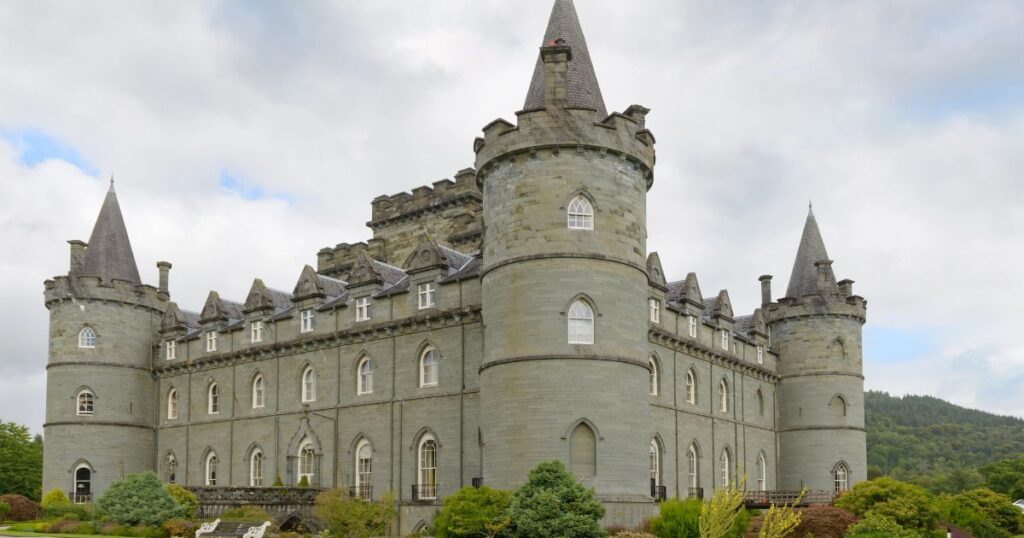
The exterior grounds of Inveraray Castle are just as memorable as the interiors, offering sweeping Highland landscapes, sculpted gardens, and breathtaking views over Loch Fyne. The estate blends 18th-century landscaping, natural woodland beauty, and panoramic photography spots that draw travelers from around the world.
The Formal Gardens
Planned as part of the castle’s 18th-century redesign, the formal gardens surrounding the castle create a picturesque frame of symmetry, color, and refinement. These are some things you can expect to see:
- Neatly manicured lawns leading toward the castle’s Gothic façade
- Seasonal flower beds filled with vibrant reds, blues, and yellows throughout spring and summer
- Sculpted shrubs and ornamental trees that enhance the castle’s dramatic silhouette
- Wide gravel paths perfect for peaceful strolls and photography
The gardens are especially beautiful in early summer, when the borders burst into bloom and the castle’s pale stone stands out against bright Highland skies.
The Woodland Walks
Beyond the manicured lawns, Inveraray’s sprawling estate offers miles of woodland paths, many of which follow natural contours of the hillside and the edge of Loch Fyne. Highlights of the estate include:
- Serene forest trails lined with beech, fir, and ancient oaks
- Quiet footpaths ideal for walkers, birdwatchers, and nature photography
- Shaded groves and scenic turns that reveal new castle viewpoints
- Seasonal color — lush greens in summer, copper and gold in autumn
These wooded areas give the estate a timeless, almost fairytale atmosphere.
Loch Fyne Views
The castle’s location along Loch Fyne is one of its greatest assets. From the lawns and the lower paths, you’ll enjoy:
- Sparkling water views stretching toward the mountains
- Dramatic reflections of the castle in calm conditions
- Soft morning mists rising from the loch
- Golden-hour light that bathes the landscape in warm tones
It’s one of the most picturesque lakeside castle settings in Scotland.
The Parkland
The wider estate includes rolling parkland dotted with grazing sheep and Highland cattle – a quintessentially Scottish scene. Designed in the 18th century following the ideals of the “picturesque movement,” the parkland was meant to appear natural while still carefully planned, and you’ll see:
- Sweeping meadows sloping gently toward the water
- Tree-lined avenues with long sightlines
- Framed castle vistas perfect for landscape photographs
All together, the grounds help Inveraray feel like both a stately residence and a Highland pastoral retreat.
Notable Figures and Events
These figures shaped the castle’s story and Scotland’s political landscape.
- The Dukes of Argyll — hereditary chiefs of Clan Campbell, influential in Scottish and British politics
- Archibald Campbell, 1st Duke of Argyll — a central figure in Scotland’s early union with England
- The 3rd Duke of Argyll — mastermind behind building the current castle
- Queen Victoria — visited Inveraray during her travels in the Highlands
- The Campbell family — still residing in the castle today
Each generation added to the estate, leaving layers of history in their wake.
Legendary Tales and Local Lore
Like many ancient Scottish castles, Inveraray has accumulated layers of lore – stories passed down from centuries of Highland tradition, clan memory, and whispered superstition.
The Harpist’s Ghost
One of Inveraray’s most famous legends tells of a harpist who was killed in the castle centuries ago. According to stories passed down through generations, the ghostly figure occasionally appears near the Armoury Hall, accompanied by the faint sound of harp strings. Visitors and staff describe:
- A soft, distant melody, as though drifting from another room
- A flicker of movement near the upper balconies
- A sense of presence in the quieter corners of the hall
Whether myth or imagination, the story adds a poetic – and slightly eerie – touch to the castle’s martial history.
The Grey Lady
The Grey Lady is said to inhabit one of the castle’s older towers. Traditionally associated with a sorrowful noblewoman from the Campbell family line, she is rumored to appear during times of loss or transition. Some visitors have reported:
- A cool breeze passing suddenly through an otherwise still room
- A soft shadow drifting near stairwells
- A quiet, inexplicable sense of melancholy
Her story mirrors many tragic noblewoman legends threaded throughout Scotland.
Clan Campbell Legends
As the ancestral seat of the Dukes of Argyll, Inveraray is tied to centuries of Clan Campbell lore:
- Feuds, alliances, and Highland politics
- Tales of bravery and betrayal
- Stories involving royal visits and political power
While these aren’t supernatural legends, they are an important part of the castle’s cultural identity – particularly for travelers tracing clan heritage.
Why Visit Inveraray Castle
Inveraray Castle isn’t just a beautiful Gothic estate – it is one of the most distinctive and atmospheric castles in the Scottish Highlands. Travelers visit for its architectural beauty, clan history, waterfront setting, and superb interiors. Here’s why Inveraray Castle stands out:
A Unique Marriage of Gothic Romance and Highland Grandeur
Few Scottish castles blend Gothic Revival architecture with baronial elegance as seamlessly as Inveraray. The four corner turrets, symmetrical façade, and gleaming stone create a fairytale-like impression unlike any other major castle in Scotland.
Home of Clan Campbell & the Dukes of Argyll
For anyone interested in Scottish clan history, this is sacred ground. Inveraray has been the Campbell family seat since the 18th century, and its collections, portraits, and documents reflect centuries of political influence and Highland heritage.
Extraordinary Interiors
From the soaring Armoury Hall to the pastel-colored drawing rooms, Inveraray’s interiors are polished, warm, and deeply atmospheric. Many travelers consider them some of the most beautiful castle rooms in Scotland.
Stunning Loch Fyne Location
The setting alone is worth the journey – glassy waters, wooded hills, grazing sheep, and constantly changing Highland light create a spectacular backdrop for photography.
A Castle That Still Feels Like a Home
Parts of the estate remain in active residential use. This gives the castle a welcoming, lived-in feeling that distinguishes it from more museum-like sites.
If you’re planning a castle-themed itinerary through Scotland, Inveraray deserves a top spot on your list.
If you’re building a Highlands-and-Islands itinerary, be sure to include Dunvegan Castle on the Isle of Skye for a completely different coastal castle experience.
Visiting Inveraray Castle Today: What To Expect
A visit to Inveraray Castle offers a smooth, enjoyable experience suitable for all travelers. Here’s what your visit will look like:
Entrance & Orientation
You’ll enter through the main gate, walk along the landscaped approach, and arrive at the impressive façade. The interiors follow a logical visitor route, starting with the Armoury Hall and progressing through drawing rooms, state rooms, and displays.
Crowds & Timing
The castle is popular, especially in summer and on weekends. Mornings before 11am and late afternoons are the quietest.
Photography
Photography is generally permitted, though flash may be restricted in some rooms.
Gardens & Grounds
Be sure to allow time for the gardens and woodland walks – many travelers consider them the best part of the visit.
Time Needed
Most visitors spend 1.5 to 2.5 hours – longer if you explore the grounds thoroughly.
Planning Tips for the Best Experience
- Book ahead during summer or cruise-ship days.
- Wear good shoes — the grounds are extensive.
- Allow time for the gardens; they’re a major highlight.
- Visit the tearoom for Highland soups, baked goods, and light meals.
- Combine with Inveraray town, which offers shops, cafés, and waterfront walks.
Getting There
- By Car: 60–90 minutes from Glasgow; on-site parking available
- By Bus: Regular service from Glasgow, Oban, and local villages
- By Tour: Many West Highlands day tours include Inveraray
- By Foot: Easy stroll from Inveraray town center
Visitor Information
Hours, ticket details, and seasonal schedules can change – be sure to double-check the official website before planning your visit.
- Hours: Typically April – October. Access is reduced during the winter.
- Admission: Separate castle + garden pricing.
- Accessibility: Partial wheelchair access. Some limitations in upper rooms.
Nearby Attractions
- Inveraray Jail
- Loch Fyne waterfront
- Argyll Forest Park
- Crarae Garden
- Kilchurn Castle (a spectacular ruin nearby)
Frequently Asked Questions About Inveraray Castle
Is Inveraray Castle worth visiting?
Yes! It’s one of Scotland’s most elegant and scenic historic estates.
How long does it take to visit?
Plan 1.5–2.5 hours for the castle and gardens.
Can you take photos inside?
Yes, photography is permitted in most rooms.
Is Inveraray Castle still lived in?
Yes – it remains the home of the Duke of Argyll and his family.
When is the best time to visit?
Late spring and early autumn offer ideal weather, flowers, and lighter crowds.
Conclusion
Inveraray Castle blends aristocratic grandeur, Gothic-Palladian architecture, clan heritage, and breathtaking Highland scenery into one unforgettable visit. Whether you’re exploring the state rooms, admiring the lochside landscape, or diving into Campbell history, this estate offers one of the richest and most rewarding castle experiences in Scotland.
If you’re planning a wider Scottish history or castle itinerary, pair Inveraray with Stirling Castle, Edinburgh Castle, Glamis Castle, Eilean Donan Castle, and explore our full Castles in Scotland guide.
If you’re exploring more Highland estates, you may also enjoy Dunrobin Castle, one of Scotland’s most dramatic château-style castles overlooking the Moray Firth. And, if you are looking for another grand Scottish estate along the west coast, you may also like my full guide to Culzean Castle, a coastal clifftop castle with impressive gardens and dramatic views. And Blair Castle in Perthshire offers another fascinating look at Highland history and aristocratic life.

